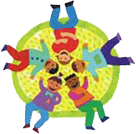Yoga and Meditation for Children with Special Needs: Benefits and Tips
My yoga and meditation journey started after a lower back injury sustained in a car accident. Little did I know that doing yoga was going to change my life and lead me to become a yoga instructor in the special needs community.
As I began to practice consistently, I became curious about yoga’s accessibility to individuals with special needs. Yoga has become a mainstream fitness activity but continues to not be that available to the special needs community. In my search, I was able to find and train with Sonia Sumar, a yoga professional who has been training professionals and parents to work with individuals with special needs for over 40 years.
This wonderful and ancient practice of Yoga can be beneficial and accessible to everyone including individuals with special needs and trauma-related experiences. Given individual challenges, children with special needs might be dealing with issues related to physical and emotional regulation; focus and attention; anxiety; depression; social interactions; speech and language; and motor skills. With consistent practice, yoga can provide beneficial support to help children manage their challenging issues and also increase their self-esteem.
Some people might ask, can a person with special needs stay regulated and focused to do yoga?
Absolutely! Yoga for the special needs child is a practice specifically geared to work with children with special needs and/or trauma. The main point here is that if a child can get the specific accommodations and is able to maintain a consistent yoga and meditation practice, this often leads to therapeutic benefits which promote regulation, reduce anxiety, and build strength and confidence.
When we meditate, we breathe and quiet the mind. Breathing and focusing on our breath resets the nervous system and settles our mind. It can be beneficial to start with 1-5 minutes of meditation per day.
In yoga, we move our bodies and hold poses while focusing on the breath. Within the practice, we are strengthening gross motor abilities, developing balance, resetting the nervous system, releasing tension, and building up concentration. More specifically, for individuals on the spectrum or those recovering from trauma, practicing yoga in a structured format with an experienced teacher often can lead to surprising healing over time.
Techniques Accessible to Children with Special Needs
Here are some breathing techniques and yoga postures that can be adapted for any child:
1-5 Minute Meditation-
- Find an object to focus on
- Support the child and help them pick an object.
- Sit in a chair or with cross legs on the ground with a nice tall spine.
- Set a timer for one minute and have them focus on just this object and breathing in and out. Prompt throughout the minute to come back to focusing on the object If their thoughts take them elsewhere.
- Remind them to breath in and out.
- More time can be added to this exercise if the child seems to be able to focus longer.
3×3 Breathing-
- Inhale for a count of three (1,2,3) and exhale for a count of three (1,2,3)
- Repeat this technique 3 to 10 times or until the child appears regulated
- This breathing technique can be done laying down, sitting in a chair or sitting cross legged on the ground.
Ocean Breath-
- Take an inhale through the nose and then exhale out of the mouth creating an ocean sound.
- Repeat this technique 3 to 10 times or until the child appears regulated.
- This breathing technique can be done laying down, sitting in a chair or sitting cross legged on the ground.
Legs on the Chair-
- You will need a table or desk chair for this exercise.
- Support the child in laying on the ground and place their legs up on the chair.
- This technique has been known to help with exhaustion and resetting.
- The child can focus on breathing in this position for 3-10 minutes or longer if wanted.
Eagle Hugs-
- Prompt the individual to give themselves a hug touching their fingertips to their shoulder blades.
- Then have them relax their chin towards their chest and focus on breathing in and out for a couple minutes.
- Repeat this having them switch the crossing of their arms.
Tree Pose-
- Stand on one leg.
- The opposite foot will be placed on the ankle, calf or the inner thigh above the knee (find a position where balance can be held for 3-5 breaths. This pose can also be done lying down).
- Hand can be placed on the hips, in prayer at the chest or reaching up to the sky (again find a place where the balance can be maintained for 3-5 breaths).
- Repeat this pose on the other leg.
I hope these simple yoga techniques and postures are helpful to your child.
Remember ………
It is beneficial to create a routine with yoga, practicing the same breath techniques and poses daily. The consistency establishes a routine in order to maintain regulation; providing your child with a sense of mastery.
Good luck on your journey.
Clarissa Cota, MAClarissa Cota has worked in the field of autism for 16 years and has been a VHAP supervisor for 8 years. She has practiced and earned a yoga certificate, RYT 200, Yoga for the Special Child Licensed Practitioner.
